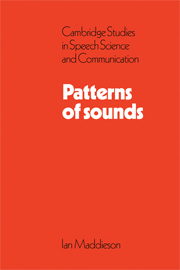Book contents
- Frontmatter
- Contents
- Dedication
- Preface
- 1 The size and structure of phonological inventories
- 2 Stops and affricates
- 3 Fricatives
- 4 Nasals
- 5 Liquids
- 6 Vocoid approximants
- 7 Glottalic and laryngealized consonants
- 8 Vowels
- 9 Insights on vowel spacing
- 10 The design of the UCLA Phonological Segment Inventory Database (UPSID)
- Appendix A Language lists and bibliography of data sources
- Appendix B Phoneme charts and segment index for UPSID languages
- Frontmatter
- Contents
- Dedication
- Preface
- 1 The size and structure of phonological inventories
- 2 Stops and affricates
- 3 Fricatives
- 4 Nasals
- 5 Liquids
- 6 Vocoid approximants
- 7 Glottalic and laryngealized consonants
- 8 Vowels
- 9 Insights on vowel spacing
- 10 The design of the UCLA Phonological Segment Inventory Database (UPSID)
- Appendix A Language lists and bibliography of data sources
- Appendix B Phoneme charts and segment index for UPSID languages
Summary
Introduction
For reasons to do with both acoustic similarities and common phonological patterning, laterals and r-sounds have been grouped together as “liquids” in phonetic tradition. Although the similarities involve principally the voiced non-fricative segments concerned (Goschel 1972; Bhat 1974), the term liquid in this paper will be applied to all lateral segments except lateral clicks and to all sounds that are included in the somewhat heterogeneous class of r-sounds. The core membership of this latter class consists of apical and uvular trills, taps and flaps. Added to this core are a variety of fricative and approximant sounds which seem acoustically or articulatorily similar, or which are related by diachronic processes (Lindau-Webb 1980).
Overall frequency of liquids
Using the definition above, almost all languages in the UPSID sample of 317 languages have at least one liquid, that is 95.9% of them do. Most languages, that is 72.6%, have more than one liquid. Details of the distribution are given in Table 5.1. The patterns found for systems of each size will be analyzed in Section 5.5 below, following an examination of the occurrence of particular types of liquids. As far as the two major classes of liquids are concerned, some 81.4% of languages have one or more lateral segments, whereas 76.0% have one or more r-sounds. The total number of laterals occurring in the surveyed languages is much greater than the difference between these percentages would suggest, since there are more languages with greater numbers of laterals.
- Type
- Chapter
- Information
- Patterns of Sounds , pp. 73 - 90Publisher: Cambridge University PressPrint publication year: 1984

